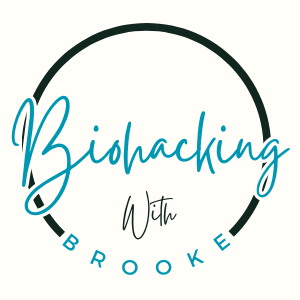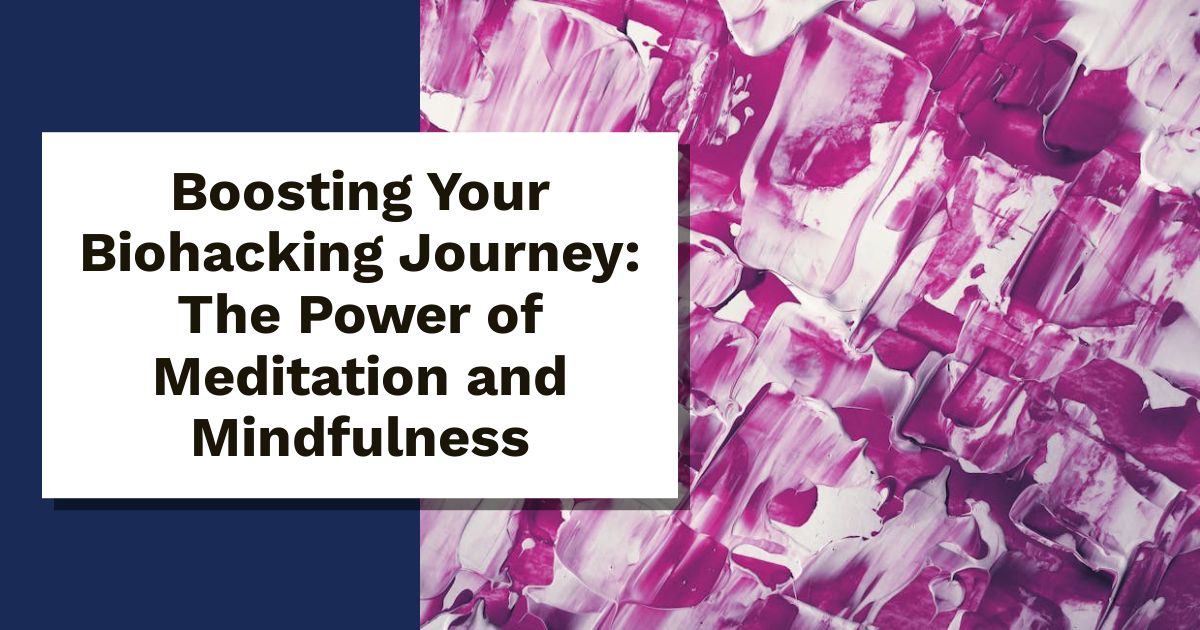Are you ready to supercharge your biohacking journey? Meditation and mindfulness might just be the secret ingredients you’ve been missing. These practices offer you ways to sharpen your mental clarity and boost your physical performance.
In a world full of distractions, finding focus can feel challenging. That’s where meditation and mindfulness come in. They help you cut through the noise, giving you the mental edge needed to reach your goals.
In this post, you’ll discover how to integrate these techniques into your daily routine. Get ready to elevate your biohacking game, unlock your full potential, and feel energized like never before.
Understanding Biohacking
Biohacking is a fascinating concept that blends biology with self-improvement. It’s about taking control of your body and mind to enhance your life. This can involve everything from dietary adjustments to using technology aimed at boosting your health. Biohacking not only focuses on external changes but also emphasizes internal optimization.
What is Biohacking?
Biohacking refers to the practice of making small, strategic adjustments to your lifestyle and biological systems to improve health and performance. It encompasses various techniques and practices that individuals use to “hack” their bodies and minds. Whether it’s through nutrition, exercise, or tech gadgets, biohacking empowers you to take charge of your well-being. For a more in-depth look, check out this resource on Biohacking Explained.
Key Principles of Biohacking
Several key principles define biohacking:
- Self-Experimentation: The cornerstone of biohacking is experimentation. Individuals test various diets, supplements, and workouts to see what works best for them. This trial-and-error approach helps in fine-tuning personal health practices.
- Optimization: Biohackers focus on maximizing performance. This includes tracking metrics like sleep quality, energy levels, and productivity to find areas for improvement. Techniques can range from intermittent fasting to nootropics.
- Holistic Health: Biohacking views health from a comprehensive angle. This means considering physical, mental, and emotional well-being. Approaches may involve meditation, mindfulness, or specific fitness regimens. To understand more about these principles, visit Key Principles of Biohacking.
Why Mindfulness Fits In
Mindfulness plays a critical role in biohacking for several reasons:
- Stress Reduction: Mindfulness helps in managing stress. This is essential since stress can negatively impact physical health and mental clarity. Biohackers often include mindfulness practices in their routines to assist in stress management.
- Enhanced Focus: Being mindful means being present in the moment. This capability can lead to improved concentration and mental performance. Biohackers find that enhanced focus leads to better outcomes in all areas of life.
- Empowerment through Awareness: Mindfulness promotes self-awareness. By understanding your thoughts and feelings, you gain insights that can lead to effective changes in both mindset and lifestyle. This aligns perfectly with the biohacker’s goal of optimizing individual health. Learn how mindfulness can enhance your biohacking journey on this site about Mindfulness and Biohacking.
The Science Behind Meditation and Mindfulness
Meditation and mindfulness are more than just buzzwords; they are powerful tools with a solid scientific backing. These practices can significantly impact your mental and physical health. Understanding the science behind them can motivate you to integrate these habits into your biohacking journey.
Benefits for the Brain
Meditation does wonders for your brain. Not only does it help you relax, but it also promotes neuroplasticity—the brain’s ability to reorganize itself by forming new neural connections. This means your brain can adapt and grow, even as you age. Research shows that regular meditation can enhance cognitive functions like memory, attention, and problem-solving skills.
How does this work? When you meditate, you strengthen connections in brain regions associated with attention and emotional regulation. This can lead to increased cognitive reserve, making you more resilient to age-related decline. Studies have demonstrated that mindfulness meditation can reduce age-related brain degeneration and improve cognitive functions. Check out this article on Does meditation enhance cognition and brain plasticity? for more insights.
Effects on Physical Health
The impacts of meditation extend beyond brain health to physical wellness. Stress can wreak havoc on your body, leading to all sorts of health issues. Meditation can help combat these effects by reducing stress levels and promoting relaxation.
Here’s how meditation influences your physical health:
- Stress Reduction: Regular practice lowers cortisol levels, the primary stress hormone. This can lead to decreased anxiety and a calmer state of mind.
- Immune System Boost: Studies reveal that intensive meditation can activate your immune system, making it more robust. This means you’re better equipped to fend off illnesses. You can learn more about this in Meditation brings robust immune system activation.
- Inflammation Regulation: Mindfulness can help regulate inflammation markers in your body, providing protective effects against various diseases. Explore the findings in Mindfulness meditation and the immune system.
Emotional Stability
Mindfulness isn’t just about focusing your mind; it also plays a crucial role in emotional regulation. Practicing mindfulness can help you become more aware of your emotions, reducing reactivity and increasing your ability to manage them effectively.
Here’s how mindfulness contributes to emotional stability:
- Decreased Emotional Reactivity: It allows you to pause and reflect before reacting to emotional triggers, leading to healthier responses.
- Increased Compassion: Mindfulness encourages a more compassionate attitude, both towards yourself and others, which can enhance your relationships.
- Better Stress Management: By improving your awareness of thoughts and feelings, mindfulness helps alleviate feelings of stress and anxiety.
For more in-depth information, check out Mindfulness: What You Need To Know.
In summary, the science behind meditation and mindfulness reveals a treasure trove of benefits that can elevate your biohacking efforts. Whether it’s enhancing brain function, improving physical health, or achieving emotional stability, these practices offer significant value on your journey to optimization.
Meditation Techniques for Biohackers
Meditation is a powerful tool for biohackers seeking to enhance their mental and physical performance. With various techniques available, finding the right one for your lifestyle can make a significant difference. Let’s explore some of the most effective meditation techniques tailored for those on a biohacking journey.
Mindfulness Meditation: Describe the basics and how to start
Mindfulness meditation focuses on being present and fully engaging with the moment. It’s about observing your thoughts, feelings, and bodily sensations without judgment. Here’s how to get started:
- Find Your Space: Choose a quiet spot where you won’t be disturbed.
- Set a Timer: Start with just 5-10 minutes. Gradually increase the time.
- Get Comfortable: Sit or lie down in a relaxed position.
- Focus on Your Breath: Pay attention to your inhalation and exhalation. If your mind wanders, gently bring your focus back.
- Expand Your Awareness: Gradually, begin to notice sensations in your body and sounds around you.
Curious to dive deeper? Visit Getting Started with Mindfulness for more tips.
Transcendental Meditation: Explain this technique and its benefits
Transcendental Meditation (TM) is a simple technique designed to promote relaxation and stress reduction. Practiced for 15-20 minutes twice a day, TM involves silently repeating a specific mantra.
The benefits of TM include:
- Reduced Stress: Practitioners often experience lower anxiety and improved well-being.
- Better Sleep: Regular practice may lead to enhanced sleep patterns.
- Enhanced Creativity: TM can foster clearer thinking and creativity.
For a detailed look at TM’s benefits, check out this resource from the Cleveland Clinic.
Guided Visualization: Discuss how visualization can enhance performance
Guided visualization uses mental imagery to enhance performance, making it a favorite among athletes and biohackers. This technique involves imagining yourself succeeding at your goals. By visualizing the process, you’re programming your mind for success.
Here are some steps to effectively use guided visualization:
- Set a Clear Goal: Identify what you want to achieve.
- Create a Vivid Mental Image: Visualize the steps it takes to reach that goal in detail.
- Engage Your Senses: Imagine what you see, hear, and feel as you succeed.
- Practice Regularly: Incorporate visualization into your routine to reinforce the mental image.
Explore more about this technique and its effects on performance at The Power of Visualization.
Breathing Techniques: Include methods like box breathing and their benefits
Breathing techniques, such as box breathing, can dramatically boost your focus and calm your mind. Box breathing is particularly popular among biohackers for its simplicity and effectiveness.
Here’s how it works:
- Inhale: Breathe in for a count of four.
- Hold: Hold your breath for four counts.
- Exhale: Breathe out for four counts.
- Pause: Hold your breath again for four counts.
Benefits include:
- Stress Reduction: Activates the body’s relaxation response.
- Mental Clarity: Improves focus and concentration.
- Emotional Control: Helps manage anxiety and enhances emotional regulation.
For a deeper understanding of box breathing, visit How Box Breathing Can Help You Destress.
These meditation techniques can complement your biohacking journey, promoting a balance between body and mind while driving performance enhancement. Explore each method to discover what resonates with you, and implement these practices into your daily routine for optimal results.
Incorporating Mindfulness into Daily Routine
Integrating mindfulness into your daily routine can significantly enhance your biohacking journey. By adopting simple practices, you can stay balanced, focused, and energized throughout the day. Let’s explore how to weave mindfulness into your mornings, workday, and days off.
Morning Mindfulness Practices
Starting your day with intention sets the tone for everything else. Here are some easy ways to include mindfulness in your morning routine:
- Mindful Wake-Up: As soon as you wake up, take a few deep breaths. Notice the sensations in your body and express gratitude for a new day.
- Mindful Movement: Try gentle stretching or yoga. This can awaken your muscles and prepare your mind for the day ahead. Even a few minutes of simple movement can make a difference.
- Meditation: Dedicate just 5-10 minutes to meditation. You can do this in silence or listen to a guided session. Starting with something like How to Start Your Day with Meditation can provide a solid foundation.
- Mindful Breakfast: Turn your breakfast into a ritual. Focus on the taste, texture, and aroma of your food. This simple practice can transform a mundane task into a mindful moment.
- Create Your Own Ritual: Design a morning routine that resonates, incorporating elements like journaling or reading. Get inspired by How to Create Your Own Morning Ritual.
Mindfulness at Work
Staying mindful during the workday can improve focus and productivity. Here are some strategies:
- Short Mindful Exercises: Set aside a few minutes to practice mindfulness exercises like deep breathing. This can help refocus your energy, especially during busy periods. Try simple techniques from 10 Ways to be More Mindful at Work.
- Mindful Reminders: Use reminders throughout the day to take a moment to pause and breathe. Sticky notes on your desk can serve as a great visual cue.
- Single-Tasking: Instead of multitasking, focus on one task at a time. This approach helps maintain clarity and can reduce feelings of overwhelm.
- Mindful Communication: Listen actively during conversations. Instead of planning your response while the other person is talking, be present. This not only improves understanding but also fosters stronger relationships.
- Create a Mindful Workspace: Surround yourself with items that promote calm, like plants or calming artwork. Incorporating elements from Mindfulness at Work can enhance your workspace.
Unplug and Recharge
Taking breaks is essential for maintaining mindfulness and energy levels. Here’s how to do it effectively:
- Scheduled Breaks: Plan short breaks throughout your day. Stepping away from your desk can refresh your mind. Aim for 5-10 minute breaks every hour.
- Micro-Breaks: Even a minute to stretch or breathe deeply can work wonders. Research shows that micro breaks can significantly decrease stress and improve focus. Check out Micro breaks: the importance of taking a break from work for tips.
- Nature Time: If possible, spend your break outside. Nature has a calming effect that can enhance your overall well-being.
- Mindful Pausing: Use breaks to practice mindfulness. Close your eyes and focus on your breath, or simply observe your surroundings. This practice can recharge your mental batteries and enhance productivity.
Adopting these practices can lead to a more focused, energized approach to biohacking. Remember, integrating mindfulness doesn’t have to be complicated—simple practices can create a significant impact!
Tools and Apps for Mindfulness
Incorporating mindfulness into your biohacking journey is easier than ever thanks to an array of tools and apps. Whether you’re looking to meditate better or track your mental state, there’s something for everyone. Here’s a closer look at some useful meditation apps and biohacking gadgets you can consider.
Top Meditation Apps
Finding the right meditation app can help you fit mindfulness into your busy life. Here are some popular choices, each catering to different needs:
- Headspace: Known for its simple interface and extensive library, it helps beginners with guided meditation sessions. It targets stress, sleep, and focus. Learn more at The Best Meditation Apps, Tried and Tested in 2024.
- Calm: This app offers meditation, sleep stories, and relaxation techniques to help you unwind. It’s particularly great for anyone looking to enhance their sleep quality. Check it out on The 4 Best Meditation Apps of 2024.
- Insight Timer: A free app with thousands of guided meditations, it also includes a vast music library for relaxation. Explore it here: Mindfulness Apps.
- Smiling Mind: Specifically designed for all ages, this app provides mindfulness programs that focus on health and well-being. You can find it at The Best Meditation Apps.
- 10% Happier: Great for skeptics of meditation, it offers practical advice and meditations from leading experts.
Biohacking Gadgets
Track your mental state and optimize your mindfulness practice with these biohacking gadgets:
- Muse Headband: This brain-sensing headband tracks your brain activity during meditation, providing real-time feedback to improve your practice. This feedback loop can enhance mindfulness and deepen your meditation sessions.
- Oura Ring: This smart ring tracks sleep, activity, and readiness levels. Understanding your body’s signals can guide when to meditate for maximum impact.
- Neurofeedback Devices: Gadgets like the Neurosity Notion use algorithms to measure brain activity, helping you achieve a calm state. The data can guide your mindfulness practices effectively.
- TMS Stimulation Devices: Some biohackers use transcranial magnetic stimulation (TMS) for mood regulation. It’s becoming popular for its mental wellness benefits. Learn about these options at Best Biohacking Products: Hack Your Way to Health (2024).
- Wearable Stress Monitors: Devices that track stress hormones and levels can prompt you to meditate when your body signals distress.
Exploring these tools and apps allows you to tailor your mindfulness practice to your lifestyle, amplifying your biohacking experience. Each option adds a unique touch, supporting you on your journey toward improved mental clarity and well-being.
Conclusion
Incorporating meditation and mindfulness into your biohacking journey offers a unique path to optimizing both your mind and body. These practices can elevate your focus, reduce stress, and improve emotional well-being. But how do you maintain the momentum?
Embrace Daily Practice
Consistency is key. Developing a daily routine that includes mindfulness or meditation can solidify these practices into your life. Start small—just a few minutes each day can lead to significant improvements over time. You can gradually increase the duration as you become more comfortable.
Imagine starting your morning with a few mindful breaths or a short meditation. How refreshing would it be to set a positive tone for your entire day? You can explore more strategies for daily integration in articles like The Biohacker’s Guide to Meditation and Flow States.
Explore Different Techniques
Not every meditation style will resonate with you. Don’t hesitate to try various approaches, such as mindfulness meditation, transcendental meditation, or guided visualization. Each has unique benefits that can cater to your personal preferences. For instance, if you find focusing on your breath challenging, guided meditation could offer the structure you need. Learn more about different styles at Techniques for Deepening the Meditative State and Mindfulness.
Track Your Progress
Utilizing apps and tools can enhance your experience. Consider using a meditation app that tracks your sessions and progress. This tracking can be motivating and will help you understand the benefits over time. Want to see how mindfulness can blend with technology? Check out Biohacking and Mindfulness: Combining Techniques for Optimal Well-Being.
Build a Support Network
Connecting with others who are on the same path can provide motivation and support. Join online forums or local meditation groups to share experiences and tips. Being part of a community can make your practice more enjoyable and enriching.
Stay Open and Curious
Finally, stay open to what works for you. Be curious about your journey and willing to adapt. The beauty of meditation and mindfulness lies in their flexibility. Approach your practice with a sense of playfulness and discovery, allowing it to evolve as you do.
Integrating meditation and mindfulness into your biohacking journey opens new pathways for improvement. By taking small, deliberate steps, you’ll harness the power of these practices to enhance both your mental clarity and overall well-being. For further reading, you can explore resources like BioHacking: Mindfulness and Meditation to guide your efforts.
Brooke is a rock-climbing 🧗♀️, tennis-playing 🎾, biohacking 🧬 bookworm 📚 on a mission to unlock the secrets of health, longevity, and living life to the fullest 🌟. When she’s not scaling cliffs, hitting the courts, or testing out the latest hacks, you’ll find her nose in a book or adventuring with her four-legged best friend 🐕 by her side. With a knack for turning science into simple, actionable tips, Brooke’s writing is your guide to hacking your biology and living your best, most vibrant life!


